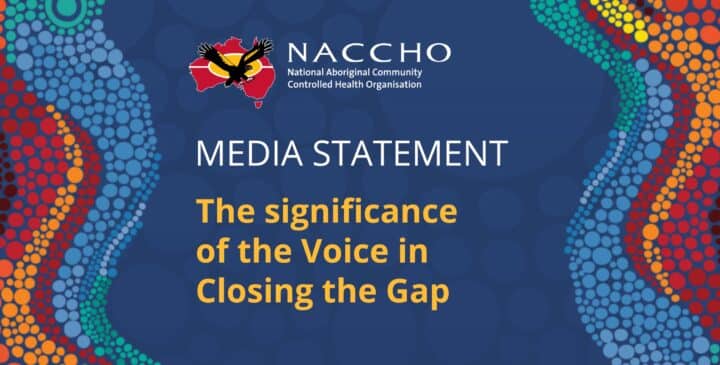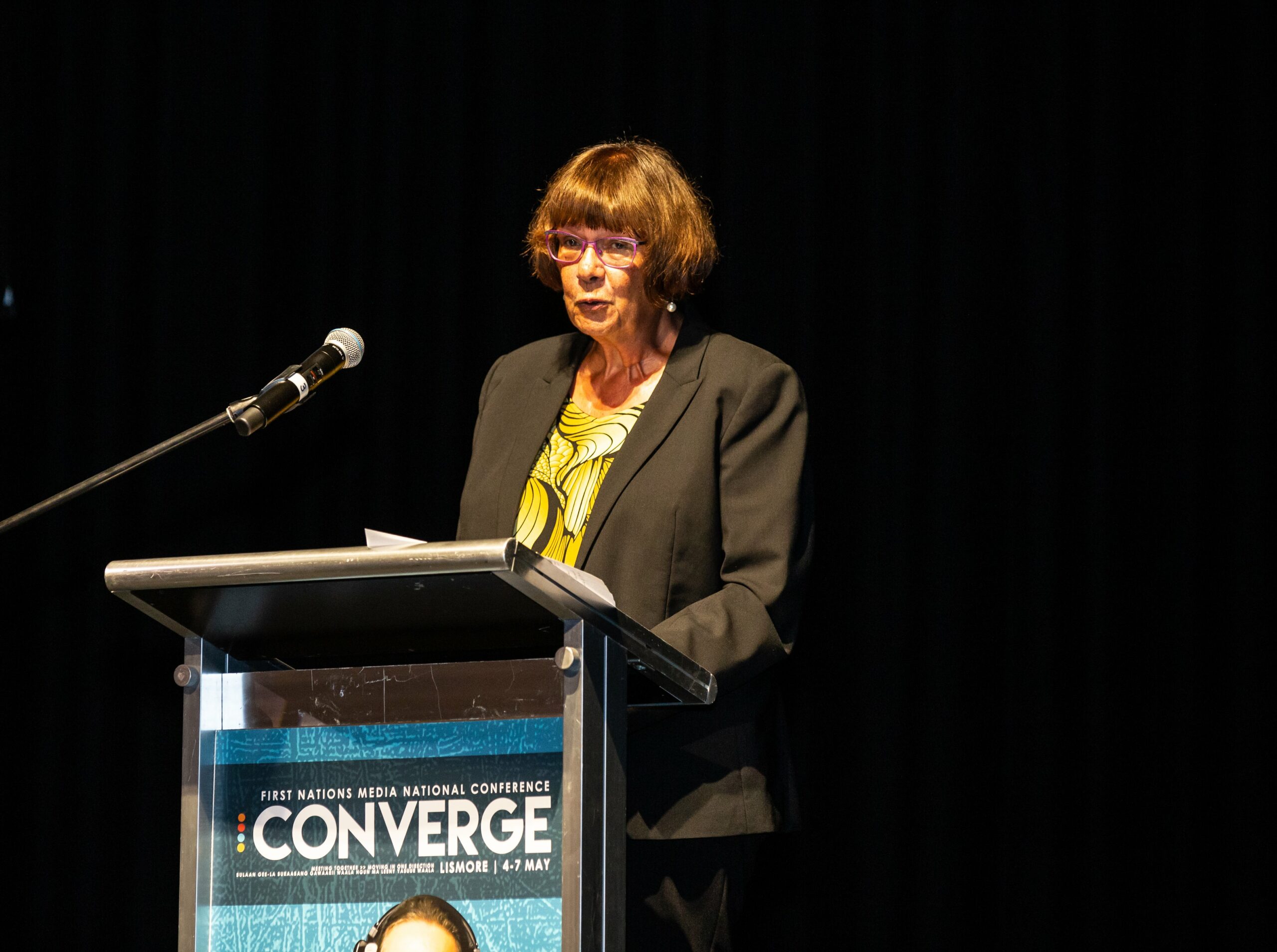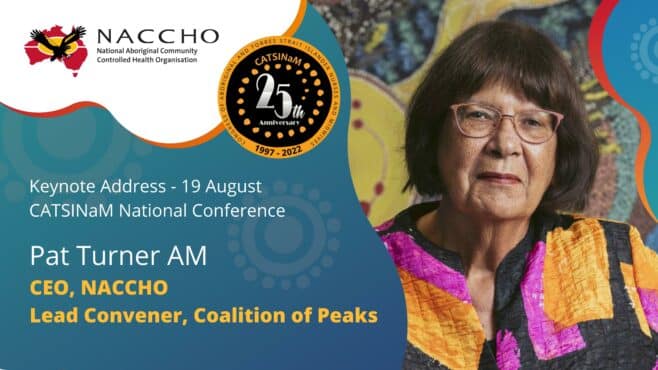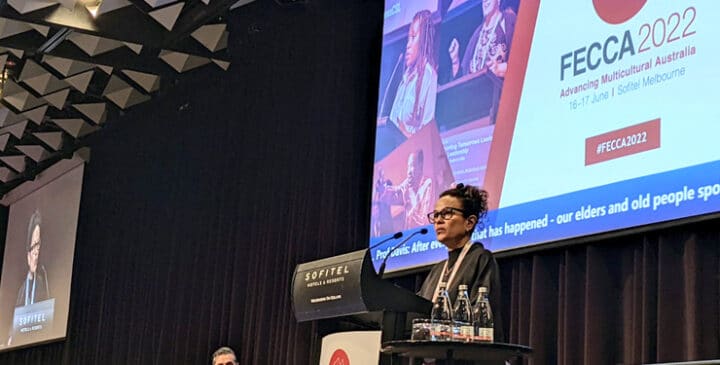

Pat Turner’s Speech at the First Nations Media CONVERGE Conference, Lismore NSW (5 May 2021)
Good morning everyone, I would like to thank First Nations Media Australia and the Koori Mail for inviting me here today to make this address.
I also thank and acknowledge the Bundjalung people, the Traditional Owners and Custodians of whose lands we are meeting on. I pay my respects to their elders Elder’s past and present. I also acknowledge the Traditional Owners of the lands some of us are joining from online today.
I am both delighted and inspired to be here today, celebrating the 30th anniversary of the Koori Mail and the coming together of one of the most vibrant community-controlled sectors – the First Nations community-controlled media network.
My name is Pat Turner, I am the CEO of the National Aboriginal Community Controlled Health Organisation, and the Lead Convener of the Coalition of Aboriginal and Torres Strait Islander Peak organisations.
Foremost, I am here as an Aboriginal woman – the daughter of an Arrente man and a Gurdanji woman.
That is how we are all here:
- as Aboriginal and Torres Strait Islander peoples
- with our own stories to tell
- to help other Aboriginal and Torres Strait Islander people tell their stories; and
- to help provide services and supports that meet the expressed needs of our peoples and communities.
Today is an opportunity to celebrate our growing voices; our growing services; and our presence in this country, that is being re-claimed.
The Koori Mail was started by Owen Carriage, a Walbunja man, who was impassioned to start an Aboriginal newspaper, due to frustrations of misrepresentations of Indigenous stories in the mainstream media.
The Koori Mail’s first edition was just 24 pages, in black and white, and read by around 25,000 people.
Today, the Koori Mail averages close to 100 pages, is alive with colour, and reaches more than 100,000 readers right around Australia every fortnight.
Thirty years of our stories.
If it is important to our mob, you’ll find it in the pages of the Koori Mail.
This is how many of our community-controlled organisations formed.
Dissatisfied with services and supports that were being provided to us.
Dissatisfied with how we were being represented in the mainstream.
Dissatisfied that we, as Aboriginal and Torres Strait Islander peoples, were not being acknowledged in mainstream services.
Our peoples have been coming together for decades now, rising to the challenge, and building organisations around the issues that are important to us – in health, legal services, early childhood, healing, and of course media.
The Coalition of Aboriginal and Torres Strait Islander Community Controlled Peaks Organisations formed with a similar purpose – to have our stories, the stories of our organisations, members and communities – front and centre in government decision making on policies and programs that have a significant impact on us.
We were dissatisfied with the way governments have been making decisions about us, without us being at the table and making them too.
And we have all been dissatisfied, angry, with the lack of control over our own lives and the corresponding lack of positive outcomes for our peoples.
The Coalition of Peaks – now over fifty-five community-controlled peaks and organisations – have made some progress in having our voices heard in government decision making.
Together with all Australian government and Local Government, the Coalition of Peaks negotiated a new National Agreement on Closing the Gap.
The National Agreement sets out commitments from all governments to change the way they work and support our organisations and communities.
The majority of these commitments are centred around four priority reforms:
- building and strengthening structures that empower Aboriginal and Torres Strait Islander people to share decision-making authority with governments
- strengthening Aboriginal and Torres Strait Islander community-controlled sectors
- systemic and structural transformation of mainstream government organisations to improve accountability and respond to the needs of Aboriginal and Torres Strait Islander peoples; and
- shared access to data and information at a regional level to support community decision making.
While there is no single strategy, idea or group that will deliver the equality and change we need and deserve, the National Agreement with the Priority Reforms as the driving agents of change, provides a significant opportunity to chart a new course for our peoples.
But for now, the National Agreement is words on a page.
The task before us is to bring it to life.
We need to hold governments to account for the commitments they have made in the National Agreement.
Too often, governments make commitments to our peoples about new ways of working, and too often those commitments are only partially implemented.
More worryingly, governments often abandon their commitments to us, without our peoples knowing, and without us being able to mobilise a response that holds government to their word.
That is why the power of the community-controlled media sector is so important in this next phase of Closing the Gap.
Our communities and organisations need to know about the commitments of governments in the National Agreement.
We all need to know and understand what the commitments mean for our organisations and communities so that we can determine for ourselves how we want the National Agreement to work for each of us.
And our communities and organisations in Alice Springs need to hear how governments are responding to the National Agreement in Mt Druitt, from Balgo to Cherbourg, and right across the country, so that we can learn from each other, inspire each other, and collectively hold governments to account.
Led by First Nations Media, the Coalition of Peaks, negotiated for the National Agreement to include a commitment to a Joint Communication Strategy, which was agreed by governments and the Coalition of Peaks in April this year.
The Joint Communications Strategy aims to build Aboriginal and Torres Strait Islander peoples’ awareness and ownership of the National Agreement, to assist us to talk to governments about how to apply its commitments to our communities and organisations across the country.
Importantly, the strategy includes a central role for Aboriginal and Torres Strait Islander media, and in particular community-controlled media, to foster and promote our own stories and ways of talking about the National Agreement.
I am excited by the power that is in the room today to tell the stories of our organisations and communities, what we are all doing to improve the lives of our peoples, and what governments should be doing to meet the commitments in the National Agreement.
In another important development, governments and the Coalition of Peaks have recently agreed to a new target on access to information: By 2026, Aboriginal and Torres Strait Islander people have equal levels of digital inclusion.
We know how important it is for our peoples to have digital access and digital literacy – it is how we can connect to education offerings; access better health services; and grow our own business and employment opportunities.
But importantly, it is also how we can access the information that we need to make more informed decisions about our own lives, tell and share our own stories; determine what we want to participate in and how; and mobilise opportunities for our families, organisations and communities.
All governments will need to set out a plan for how they will meet this target and will report annually on progress, what they have been doing and what more needs to be done.
This will include reporting and taking action on increasing the number of Aboriginal and Torres Strait Islander peoples employed in the media sector.
Governments and the Coalition of Peaks also recently agreed that more work needed to be done on understanding and then driving increased Aboriginal and Torres Strait Islander participation and representation in the media.
We know how important this area is – it is why the Koori Mail started 30 years ago.
And whilst we have significantly increased our representation and participation in media, we have more work to be done.
A big part of this work is with mainstream media organisations to make sure our voices and stories are being heard as we tell them and want them told.
Whilst these achievements might seem small, it is the first time in the Closing the Gap policy, which started in 2008, that the vital role of the community-controlled media sector has been recognised by governments.
This is an important step forward and commitment and governments. But like the other commitments in the National Agreement, it is time to bring them to life, to make the commitments real for our organisations and communities.
I know, that with the growing power of our community-controlled sectors, we can bring the National Agreement to life and start seeing positive changes in our communities where we are able to share decisions with governments about policies and programs that impact on us; strengthen our community-controlled organisations; self-determine our own lives; and have our voices heard!
Thank you.
I would now like to invite any questions that you may have.

